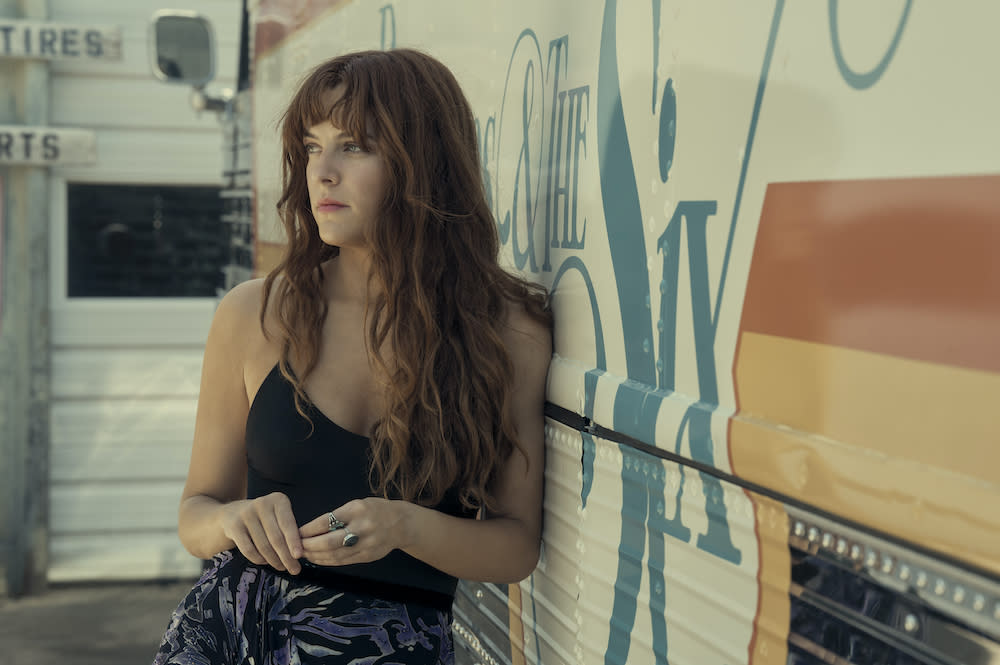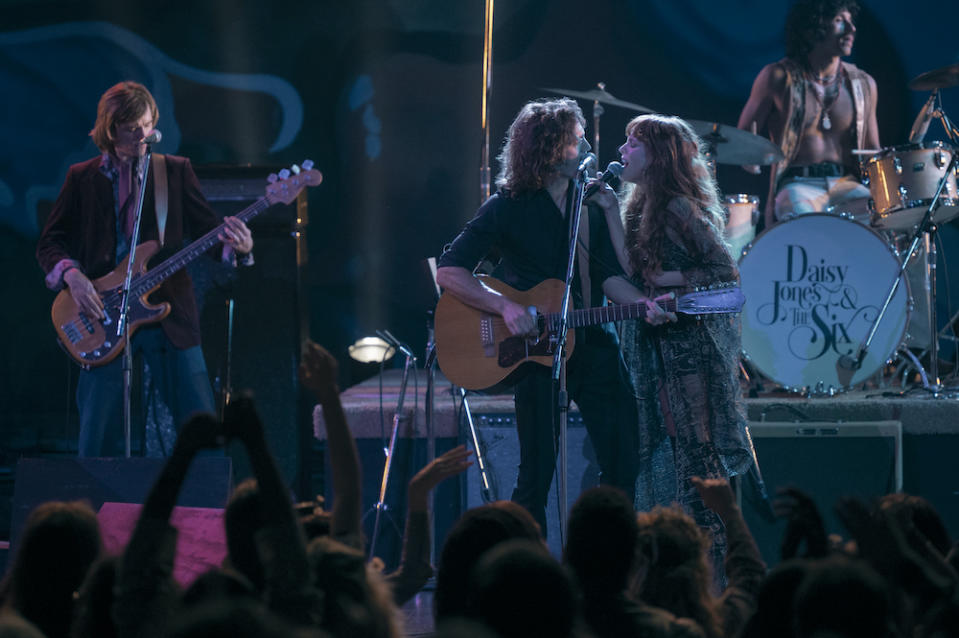Amazon’s ‘Daisy Jones and the Six’ Series Is a Cacophony of Bad Choices

The proliferation of television documentaries and mockumentaries has stretched the bounds of the format to imaginative extremes. Technology is testing our perceptions of ethical filmmaking, “Abbott Elementary” marks the latest hit sitcom to rely on talking heads for laughs, and “Documentary Now!” is an entire series made up of fake “docs” spoofing real documentaries. But whether you’re enjoying the explosion of documentary styles or fearing that a once-serious medium has jumped the shark, nothing can prepare you for the sheer lunacy on display in “Daisy Jones and the Six.” (Well, come to think of it, “Doc Now’s” brilliant two-part episode, “Gentle & Soft: The Story of the Blue Jean Committee,” comes close — but for the wrong reasons.)
Prime Video’s extensively misguided adaptation of Taylor Jenkins Reid’s 2019 novel makes its first and most notable blunder in attempting to map the book’s “oral history” template — which recounts the turbulent formation, success, and dissolution of a fictional ’70s rock ‘n’ roll band — onto a documentary structure. The series’ opening shots see each band member sitting down to be interviewed, and soon enough they’re are teeing up flashbacks to their glory days.
More from IndieWire
Except… the flashbacks aren’t actually flashbacks. If what we’re watching is supposed to be a documentary, then scenes from decades earlier should be archival footage that someone recorded back in the 70s. Initial images are given the grainy look of old film stock, but that soon disappears for traditional scenes shot like any ol’ scripted drama. So are all these incredibly intimate scenes where band members hook up or fight with each other supposed to be reenactments? If so, did the filmmakers ask the band members to play themselves while recreating those scenes? If not, how are we seeing them? There’s no explanation for how these would exist in the documentary, even when you find out who’s making it in the finale episode. If “Daisy Jones and the Six” was an actual documentary, its greatest mystery wouldn’t be, “Why did this great band break up?” but “Where did all this footage come from?”
Shooting the unshootable is a nagging problem that’s oft forgiven in sitcoms and other fake docs, when the narrative necessitates a little leeway to capture major moments. Maybe it doesn’t make sense for documentarians to be around for every scene in “Modern Family,” but eventually, you’re there for the jokes, the characters, and the story, so you let it slide. That’s hard to do here. With director James Ponsoldt’s bland, brown visual palette, “Daisy Jones” is a rock-drama steeped in self-seriousness. Every decision is life or death for these striving wannabe rock stars, and the show asks you to be right there with them; to get high on all this fictional rock ‘n’ roll lore without bothering to ask how it’s been persevered or what we’re actually watching. Worse still, after the first episode, the talking heads are mainly used as substitute for voiceover. They narrate scenes that shouldn’t need narration, or prop up scenes that don’t make sense without it.
But these storytelling choices are only the first mistake, among many, many more. From showrunners Scott Neustadter and Will Graham, “Daisy Jones and the Six” centers around a band the opening inter-title refers to as “one of the biggest in the world.” Well, they were until October 4, 1977, when DJ & The Six played a sold-out show at Chicago’s Soldier Field and then never played again. For the next 20 years, every member refused to explain why… until now, for this nonsensical documentary with a mystery producer behind the scenes. Sorry, sorry, I’m getting distracted again. Episodes focus on the mystery of how the band broke up, not how the doc was made, and unfold in chronological order (with a heavy dose of foreshadowing from the talking heads), starting with Daisy herself.
Raised by a hateful mother and absent father, Daisy grows up with an extremely low self-esteem. She loves writing and singing, but she so thoroughly believes all the bad things her mom has told her that she refuses to perform in public. Finally, after one of her songs is stolen, recorded by her ex, and proceeds to rocket up the charts, she snaps. And wouldn’t you know it? A star is born.

Courtesy of Lacey Terrell / Prime Video
Unbeknownst to Daisy, her future bandmates are practicing in Pittsburgh before a touring manager (Timothy Olyphant, in maximum parody mode) sees one of their sets and says their only shot at stardom requires moving to L.A. Brothers Billy (Sam Claflin) and Graham (Will Harrison) form the backbone of the band, along with Karen (Suki Waterhouse) on keyboards, Eddie (Josh Whitehouse) slapping da bass, and Warren (Sebastian Chacon) playing drums.
Eventually, inevitably, they cross paths with Daisy, and the show’s last embers of hope burn out. If all viewers had to deal with was a sham documentary structure, they could probably get over it, but “Daisy Jones and the Six” utterly bungles its star-crossed romance, as well. When Daisy and Billy meet — two lead singers battling for control of the band — Billy is already married to Camila (Camila Morrone) with a kid at home. He’s also been through rock star boot camp: sleeping around on tour, drinking way too much, and going to rehab. Given Daisy’s bad experience with men stealing her work, she’s similarly closed off, protective, and suspicious of this long-haired hunk trying to tell her what to do.
But their background and behavior never coalesce into anything real. Daisy, at first, is complimentary toward Billy, like one would expect a newcomer to be with the band’s de facto leader. But she almost immediately pivots to insults, telling him all his songs sound the same and openly mocking him in front of his friends. This random turn is unjustified by the narrative or the character, but it’s repeated over and over throughout the ensuing episodes, making Daisy look like an asshole — the kind of wild card who writers rely on to create chaos, without bothering to develop onscreen so her choices make sense. (It also hampers the actor; without a convincing through-line, Keough struggles to command the screen like a rock star should. The talking heads have to tell us when Daisy is amazing or entrancing because we can’t glean anything special from seeing it ourselves.)
Billy doesn’t fare much better. He’s too touchy, too full of himself, and too earnest to believe anyoPreviewne would want to spend time writing songs by his side. Claflin’s performance is all exasperation, no heart. As Billy gets older and dials things down a bit, the “Hunger Games” star settles in, but he’s completely closed off when Billy and Daisy are supposed to be bonding. An entire episode dedicated to their first songwriting session is unbearable, as every shared scene feels like it should end with them running as far away from the other person as possible — yet the script demands otherwise, and the duo struggles to engineer a believable volatility in a relationship that’s always meant to be on the fringe of something more.
“Daisy Jones and the Six” name-checks compelling ideas, like how people can confuse soul mates with mirror images, and how onstage romance can be manufactured for a marketing edge. But the series never picks a lane. By the end of the looooong 10-episode limited series, there’s decent arguments to be made that Billy and Daisy are too similar to ever get along, that they’re soul mates destined by the stars, or that they’re actual enemies forced together for the sake of others. (I lean toward the latter theory.)
Even outside of the central’s couple’s confounding relationship vortex, the show doesn’t get any better. It’s all rock ‘n’ roll cliches: jealous bandmates, raucous parties, and wild egos. You can guess how the other characters’ arcs play out from the first few scenes. (Music-heads may find more to chew on, given the novel’s Fleetwood Mac inspirations, but they still have to deal with half-formed supporting characters like “disco pioneer” Simone Jackson, played by Nabiyah Be, whose serviceable story just kind of stops when she’s no longer of any use to Daisy.)
The music isn’t bad, though. Their biggest hits (mainly “Look at Us Now (Honeycomb”) may not be stone-cold classics, but they’re believable substitutes in a series where little else is convincing — or even tries to be.
Grade: D
“Daisy Jones and the Six” premieres Friday, March 3 on Amazon Prime Video. New episodes will be released weekly through March 24.
Best of IndieWire
Sign up for Indiewire's Newsletter. For the latest news, follow us on Facebook, Twitter, and Instagram.


